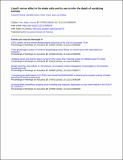Files in this item
Lloyd's mirror effect in fin whale calls and its use to infer the depth of vocalizing animals
Item metadata
| dc.contributor.author | Pereira, Andreia | |
| dc.contributor.author | Harris, Danielle | |
| dc.contributor.author | Tyack, Peter | |
| dc.contributor.author | Matias, Luis | |
| dc.date.accessioned | 2018-09-05T09:30:09Z | |
| dc.date.available | 2018-09-05T09:30:09Z | |
| dc.date.issued | 2017 | |
| dc.identifier | 255426128 | |
| dc.identifier | 48e3bd9b-006e-4b4a-a528-ddf9d5d639e1 | |
| dc.identifier | 85011024559 | |
| dc.identifier.citation | Pereira , A , Harris , D , Tyack , P & Matias , L 2017 , Lloyd's mirror effect in fin whale calls and its use to infer the depth of vocalizing animals . in Proceedings of Meetings on Acoustics . vol. 27 , Proceedings of Meetings on Acoustics , Acoustical Society of America (ASA) , 4th International Conference on the Effects of Noise on Aquatic Life 2016 , Dublin , Ireland , 10/07/16 . https://doi.org/10.1121/2.0000249 | en |
| dc.identifier.citation | conference | en |
| dc.identifier.issn | 1939-800X | |
| dc.identifier.other | ORCID: /0000-0002-8409-4790/work/60887911 | |
| dc.identifier.other | ORCID: /0000-0003-1447-1420/work/61370037 | |
| dc.identifier.uri | https://hdl.handle.net/10023/15966 | |
| dc.description.abstract | The ocean acoustic Lloyd's Mirror effect (LME) is produced by interference between the direct-path and the sea surface phase-reversed reflection of a sound as observed at a receiver. It results in a frequencydependent interference pattern that can be observed in a spectrogram. Many studies have found variations of spectral characteristics of the 20 Hz 'regular' fin whale call, which seem to reflect geographic differences. However, variability of spectral measurements may occur due to the LME. Using a bout of regular calls with estimated ranges, our study aimed to: 1) show and analyze differences of call features due to the LME; and 2) estimate the depth of the vocalizing whale. The composite spectrogram showed that different spectral characteristics of the calls could be identified within the same bout. We developed transmission loss models considering the LME for a fin whale call generated close to the surface and recorded at the sea bottom by an instrument. Our results suggested that some differences measured in fin whale calls could be related to the LME. Inference of depths of calling whale was not straightforward and needed to be assessed at a finer temporal scale than the full bout of calls. | |
| dc.format.extent | 15 | |
| dc.format.extent | 2997677 | |
| dc.language.iso | eng | |
| dc.publisher | Acoustical Society of America (ASA) | |
| dc.relation.ispartof | Proceedings of Meetings on Acoustics | en |
| dc.relation.ispartofseries | Proceedings of Meetings on Acoustics | en |
| dc.subject | QA Mathematics | en |
| dc.subject | QH301 Biology | en |
| dc.subject | Acoustics and Ultrasonics | en |
| dc.subject | NDAS | en |
| dc.subject.lcc | QA | en |
| dc.subject.lcc | QH301 | en |
| dc.title | Lloyd's mirror effect in fin whale calls and its use to infer the depth of vocalizing animals | en |
| dc.type | Conference item | en |
| dc.contributor.institution | University of St Andrews. School of Mathematics and Statistics | en |
| dc.contributor.institution | University of St Andrews. Sea Mammal Research Unit | en |
| dc.contributor.institution | University of St Andrews. Centre for Research into Ecological & Environmental Modelling | en |
| dc.contributor.institution | University of St Andrews. School of Biology | en |
| dc.contributor.institution | University of St Andrews. Centre for Social Learning & Cognitive Evolution | en |
| dc.contributor.institution | University of St Andrews. Marine Alliance for Science & Technology Scotland | en |
| dc.contributor.institution | University of St Andrews. Sound Tags Group | en |
| dc.contributor.institution | University of St Andrews. Bioacoustics group | en |
| dc.contributor.institution | University of St Andrews. Scottish Oceans Institute | en |
| dc.identifier.doi | https://doi.org/10.1121/2.0000249 |
This item appears in the following Collection(s)
Items in the St Andrews Research Repository are protected by copyright, with all rights reserved, unless otherwise indicated.

